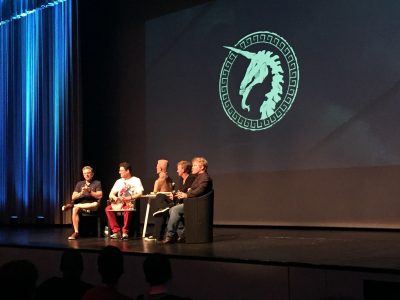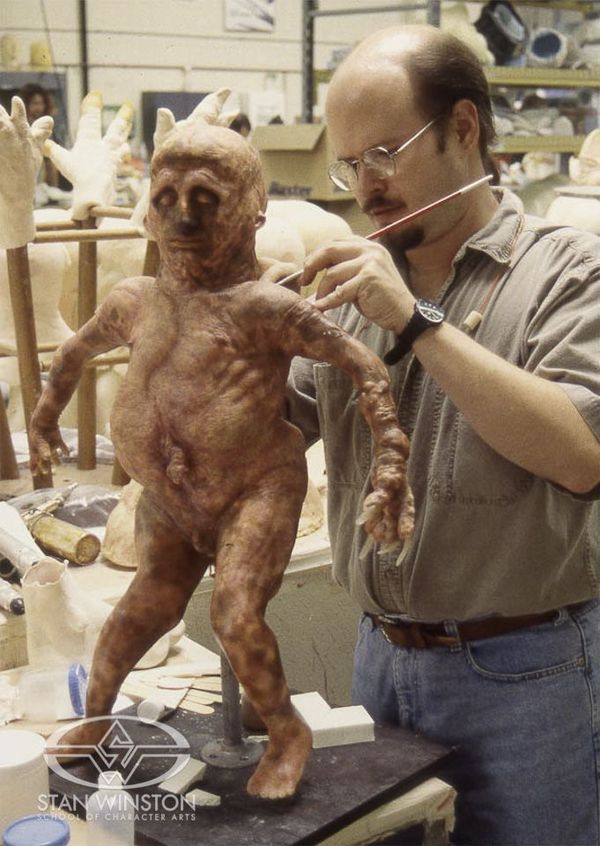“I must confess that I lost faith in the sanity of the world when I saw it suffering the painful disorder of this island.”
― H.G. Wells, The Island of Dr. Moreau
It is widely acknowledged that the 1996 film The Island of Dr. Moreau was a deeply troubled production. Richard Stanley was the original director on the project, but after four years in development he was fired by New Line only three days into filming in northern Queensland, Australia. Stanley was replaced by John Frankenheimer, who inherited a myriad of challenges – from the demanding and oftentimes eccentric stars Marlon Brando and Val Kilmer, to the former director Stanley sneaking back on set in an animal costume.

From an effects point of view, Dr. Moreau was also a complex and difficult production. Stan Winston Studio was called upon to create several of the film’s hybrid creatures, while Digital Domain realized CG versions, sometimes using motion capture in what was still relatively early days for that technology in film. Both companies had to adapt to changing scripts, the uncomfortable Australian heat and Brando’s occasional inexplicable desire to create his own make-up effects solutions on set.
Indeed, the stories coming out of the production have become legend. And here at Trojan Horse was a Unicorn in Portugal, two of the key effects players have now added to that lore. Shane Mahan, who was with Stan Winston and responsible for make-up and creature effects, and Kevin Mack, the visual effects supervisor from DD, both shared their experiences on Dr. Moreau in a panel hosted by former DD CEO Scott Ross, which also included former DD vfx supe David Prescott. Their stories had the audience in absolute stitches.
Mahan would spend six months on location in Queensland in a city called Cairns (a hot and humid tropical setting that had been chosen for its rainforest and coastal environments). He began his Moreau story by recounting his first encounter with the much-revered Brando. Stan Winston Studio had been tasked with building a replica of the ‘heavy’ actor for the end of the film when Moreau is killed and burned. That would require a life cast and Brando was supposed to come in for this process. But he never showed up.
One day, Mahan received a message that Brando was on the phone for him. Mimicking Brando’s distinctive voice, Mahan recalled the call, and how he told the actor he was the special make-up effects supervisor and needed him to come in for a life cast and a computer scan for the death scene. Brando replied cooly with, ‘What if I don’t want to die in this movie?’. He told Mahan he wasn’t going to do the life cast or scan, and that the studio needed to figure it out.
Stumped, Mahan called on his friend and fellow make-up effects supervisor Dick Smith, who had actually carried out a life cast of Brando for The Godfather around 1972 – more than 20 years earlier! But Smith still had it and sent the life cast over to Stan Winston Studio which went ahead and built a dead Brando body to use during filming.
Mahan then encountered a bizarre event almost immediately upon arrival in Australia which, says Mahan, probably set the scene for the rest of the crazy occurrences on the movie. At the opening party, the producers asked him to bring the Brando body and have it sit in a chair, slumped forward with a drink in its hand and a hat on its head. So Mahan and his team did this, and when the other actors arrived at the party they’d look strangely at the body and say, ‘Is…is that Marlon?’ They’d even go up and start talking to it, yet get no response, only later realizing it was a dummy.
Above: go retro with this link to a Quicktime VR view of Stan Winston Studio during production on Dr. Moreau.
The real Brando on set caused all sorts of mayhem. Mahan recalls that the actor refused to go to the make-up trailer but instead would apply his own make-up. This consisted of distinctive white face make-up, buck teeth and rubber gloves filled with baby powder – all techniques Brando had devised himself. He even at one stage walked past a fruit stand on a table and suggested he could make a hat out of it.
When the director Frankenheimer realized what was going on, he had Mahan go and speak to Brando in his trailer. Entering, Mahan was first asked if he wanted a Pepsi, and then immediately Brando requested that Mahan make him some monkey fingers. The actor was told yes, but an impression would have to be made of his hand, to which Brando said Mahan’s hands were of a similar size and why didn’t he just use those. Mahan did.
In the actor’s trailer, Mahan rustled up enough courage to ask Brando about the white make-up, the plastic gloves and the baby powder. ‘Oh this,’ said Brando, ‘I’m just doing this to be fucking weird.’

Another challenge faced by Mahan and the Stan Winston crew was in shooting the creatures they had labored on for many months. Originally intended to be filmed at night, this changed to daytime shots since one of the lead actors intended to go out partying in the evenings. But the creatures had actually been built with exaggerated features that would be somewhat toned down by a nighttime shoot – in the end they were all made to work for the now hot daytime environments.
Mahan also recalled Brando’s sudden connection to the distinctive actor Nelson de la Rosa playing Majai who had initially been cast in only a very minor role. De la Rosa was one of the shortest actors alive at the time, being 71 centimeters tall and purposely cast as a ‘small, flayed, sloth-like creature’ as described in H.G. Wells’ book. When Brando first eyed de la Rosa on set, he became fascinated by the actor (‘You’re telling me there’s a man in there!?’) and quickly elevated him to be in many more scenes where de la Rosa would mimic the senior actor’s movements (this is now even referred to in many circles as the inspiration for Mini-Me in the second Austin Powers film). The chain of events impacted Mahan’s team because they had only produced simple make-up effects for the small actor, considering him to be a background character. Now he had his own wardrobe that matched Dr. Moreau and would be appearing front and center with Brando.
At the same time, then Digital Domain visual effects supervisor Kevin Mack had his fair share of challenges on Dr. Moreau, too. The first was the hybrid cat/human character Aissa which was required to run through the jungle. It was suggested to Mack, he relayed to the Trojan Horse audience, that the production motion capture a real Bengal tiger for the movement of Aissa in cat form. And Digital Domain did it – by orchestrating a bluescreen mocap obstacle course in the DD parking lot (‘for a location we hadn’t shot in yet’, adds Mack). The tiger’s trainer appeared relaxed initially, but when Mack and his team once warily approached the animal, the trainer had a hard time restraining it. ‘Never more away from it,’ the trainer would say. ‘Never move away’.
DD's mocap and final animation in an old Quicktime from the original Dr. Moreau website.
With the mocap acquired, Mack soon learned however that mapping data from a tiger’s legs to that of a hybrid human was tough – remember, it was early days in mocap even though DD had been exploring the tech significantly for Titanic. Mack says the Aissa animation initially looked more like a frog, but he had little time for refinement before the film would be presented at a disastrous test screening.
At this point, only a few final shots had been completed by Digital Domain. Mack recalls the screening took place in a ’scary’ neighborhood where literally ‘gangsters’ attended the movie. Things did not start well – the film was late arriving and the air conditioning wasn’t working. Mack was terrified because he thought what the film was at that point was ‘unbelievably bad’. Indeed, when the lights came up, one of the audience members ran up to the screen and double kicked it, yelling ‘Fuck this shit!’. Mack says he was sitting there thinking, ‘I just want to live’.
Mack also had an unlikely role in the film – as an additional re-writer. The script was in constant flux and a planned plot point about the nuclear origin of the characters was rejected by Brando, who wouldn’t read the relevant dialogue. It turns out Mack had been doing a lot of his own reading about genetics and other science-related things during the many breaks in filming. He told actor Ron Perlman about this, and Perlman told Brando, who suggested they ‘get the VFX guy to write it.’ So Mack got the call to write Brando’s speech with the help of another actor on the production, and that was more or less what made it into the movie.
Above: A Quicktime VR view of Digital Domain’s studio during production on Dr. Moreau.
After hearing these war stories, it seemed like nothing else could have gone on during Dr. Moreau, but Shane Mahan had one last tale to tell. This was the story of the infamous infiltration onto the set in Cairns by the sacked director Stanley. Mahan says that each day they had local actors playing the hybrid beasts. Since they were wearing prosthetic masks in hot conditions, in breaks Mahan would suggest they take them off, although one person always seemed to keep their mask on. One day it was noticed that ‘mask 46’ was missing and eventually it was revealed that Stanley had been secretly visiting the set in full make-up.
What was so fascinating about these Trojan Horse tales from the effects crew on Dr. Moreau was that those involved weren’t bitter at all about what happened – in fact, it rather sounds like they enjoyed it. And the experience certainly demonstrated the key role of effects in making an adventurous film like this possible. Dr. Moreau was also an interesting early example of the close collaboration required between digital and practical effects that has since become even more integral and more and more seamless.
Trojan Horse was a Unicorn continues and is accessible on THU TV.
